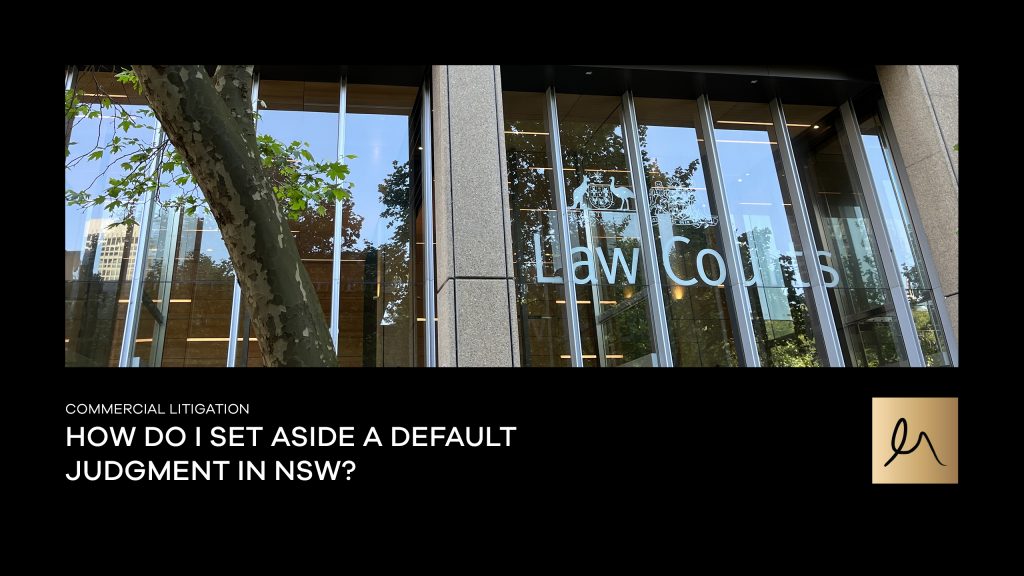In court proceedings, if you fail to file a defence within the specified timeframe the plaintiff (individual or entity which initiated the legal proceedings) can apply for a default judgment. If approved, the default judgment becomes a Court order against the defendant without an actual determination of the case.
In certain circumstances, get personalised guidance and prompt assistance from Madison Marcus, a defendant can seek to set aside the default judgment in NSW.
What is a Default Judgment?
A default judgment is a court order made in favour of the plaintiff when no defence has been filed within 28 days of the defendant being served with the statement of claim. The default judgment is the same as the regular judgment that would be awarded after a trial, however, without a hearing of the actual merits of the case.
For this reason, and in certain circumstances, a default judgment can be set aside, which will allow the defendant to file its defence and the case to continue in the usual manner to a final hearing.
Application to set aside a Default Judgment
Applications to set aside default judgments should ideally be made soon after you become aware that the Court has made a default judgment. If you delay in making the application, this can have a negative impact on the discretion to set it aside.
An application to set aside a default judgment is made pursuant to Rule 36.16(2) of the Uniform Civil Procedure Rules 2005 (NSW), which enables a court to set aside or vary a judgment or order after judgment is entered if it is a default judgment.
In order to make the application, a notice of motion and supporting affidavit will be required. It is also usual practice to include a copy of your draft defence annexed to the supporting affidavit.
What does the Court consider when setting aside a default judgment?
For a default judgment to be set aside, the court will usually consider:
- whether there is a bona fide defence to the claim.
- whether there is a reasonable explanation for the default by the defendant in filing a defence;
- whether there has been any delay by the defendant in making the application to set aside the default judgment, or any explanation for the delay.
What is a bona fide defence?
To set aside the default judgment, you will need to show that you have a bona fide (in good faith) defence to the statement of claim. You do not need to prove you could have successfully defended the case as part of the application (although that will help), you just need to attest to facts in the affidavit in support which would support a genuine defence to the claim.
The importance of a defence has been emphasised by Priestly JA in Byron v Southern Star Group Pty Ltd t/as KGC Magnetic Tapes (1995) 123 FLR 352, where people ‘have been let in to defend who have had little or no explanation for their delay but who have shown reasonable grounds of defence.’
In other words, if you have a reasonable defence to the claim, but no explanation for the delay, the court can still set aside the default judgment. This is because the fundamental duty of the Court is to do justice between the parties, so the Court will usually want the dispute resolved on the merits of the case, instead of making an order because the defendant has failed to file its defence.
What is a reasonable explanation for not filing a defence?
Without a reasonable explanation for the defendant’s default, especially if there is also prejudice to the plaintiff, this may result in the application being refused.
An example of a reasonable explanation for failing to file a defence may be that the defendant did not receive the statement of claim and was therefore not aware of it. For example, if the defendant had moved house, changed office address, or because they were away overseas.
However, if you have deliberately delayed in filing a defence and just ignored it, you will not have a reasonable explanation for the delay. In those circumstances, the bona fide defence and prospects of that defence become more important in deciding whether or not to set aside the default judgment.
Delay in making the application to set aside the Default Judgment
Once you are aware of the statement of claim, it is important that you make the application to set aside the default judgment as soon as possible.
If there is a delay in making the application, you will need to provide an explanation for the delay. For example, if you were not aware of the default judgment and can prove that the plaintiff did not serve you properly, then you can use this to explain the delay.
Need help setting aside a Default Judgment?
If you have a default judgment against you and want assistance to set it aside, or need advice for your specific circumstances, do not hesitate to contact us.
Our experienced and award-winning Commercial Litigation Lawyers are ready to assist you and guide you through the process.







